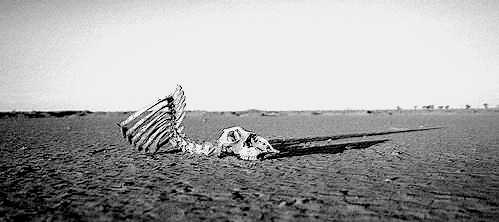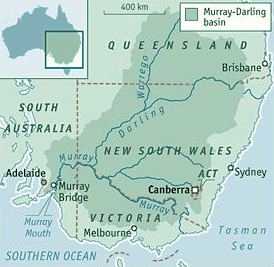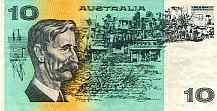
Select an article on this page.
1: Henry Lawson: The Australian Drought 1900
2: Australianisms 1883. Bush terms.
3: Henry Lawson: Blazing desolation
4: 169 Years Later and still awaiting divine intervention:
5: Learning from past mistakes
6: Serious water famine: Melbourne 1887 .
Other Drought related articles.
7: The Australian Drought a natural phenomenon.
8: Drought and Bush Fires in Victoria
1851 Black Thursday
9: Chronoloy of Australian Major Bush fires
10: Melbourne dust storm, 8 February 1983
DROUGHT-STRICKEN ( excerpts ) ( Henry Lawson 1900 )
" Haggard eyes stare vainly at every sign of a cloud for rain. The great white sun rises with almost the heat of noon; and so, day after day, week after week, month after month, until people cease to hope, or even to waste words suggesting that it might rain soon.
"The country looks awful !" they say, and that expresses it. But you couldn't
realise the drought unless you saw it - and then you couldn't realise it unless
you lived through it; and even then - well a man does not know what he can go
through and leave behind him as an evil dream. The country in the drought is
dreadful - it is enough to terrify a new-chum; "
Farmers must be helped
Help is needed.
..... These Bush people must be helped wholesale- by the Government, by
the public, by the people.
Every spare penny should be spent on water
conservation and irrigation, in sinking tanks and putting down bores, in locking
our thousands and thousands of miles of rivers - almost at sea level -
where oceans of water waste away after each flood
To attend to these
things is a national work, for the benefit of the whole nation; to neglect them
is a national crime - it is suicidal.
The big squatter, bank, or company, with many stations, have a margin for
drought losses. There may be rain on one run to make up for the losses
through drought on another; and one good season often makes up for several
bad ones.
It is the small squatter, cockatoo, selector. or farmer who suffers
so cruelly, and, in time of drought, they should not be called upon to pay
an instalment of one penny an acre on their barren lands.
I know how they slave
and how they suffer.
I was "brought up" well "inside" in "good country", yet the scrub round our
selection was dotted with dusty little patches, with the remains of a fence, a
heap of chimney stones, and the ruins of a hut - all that was left of twenty,
thirty, forty years of white slavery through blazing droughts. "
Australianisms 1883. Bush terms.
" The 'bush'--itself an old word used in a new sense--has been most
prolific in new phrases. Everyone who lives in the country, whether on a
station or in a farm, but not in a township, is called a 'bushman,'
although properly speaking this designation only applies to a person who
lives in the 'bush' or unsettled country. 'Bushranger' is another word of
the same derivation, which it is needless to explain.
Of course you know
what a 'squatter' is. It is strange that the same word which in America
is used to denote the lowest class of settlers--the man who settles upon
somebody else's land and pays no rent--is here a synonym for aristocrat.
The term 'farmer' is applied exclusively to the agriculturist, and a
squatter would be very much offended if you called him a sheep-farmer.
The squatting class in Australia correspond to the landed gentry of
England.
The farmer is usually legally known as a 'selector,' because
under the Land Act he selects a piece of ground perhaps in the middle of
the squatter's leasehold and purchases it on credit for agriculture.
A 'cockatoo' is a selector who works his piece of land out in two or three
years, and having done nothing to improve it, decamps to select in a new
district.
A 'run' is the least improved kind of land used for sheep, but
the word is used almost alternatively with 'station,' which denotes an
improved run. The run may be a mere sheep-walk, but a station is bound to
have a house attached to it, and fenced 'paddocks' or fields. "
The few words which I have given will serve as an
indication of the bent of colonial genius in the manufacture of a new
dialect; and as they are given without any effort, just as they have come
to my mind in the course of one evening's thinking as I write, they may
fairly be taken as being amongst the commonest.
" TOWN LIFE IN AUSTRALIA. " by R. E. N. TWOPENY, OFFICER D'ACADEMIE DE FRANCE,
1883
And where is
the water? that is one of the first questions that occur to you; for there is no
more sign of water than there is of grass.
The water is at the "bore", or in
a muddy hole down the creek, or in a dam or tank, with a screen of saplings and
boughs over it sometimes, to lessen evaporation.
The water is thick and yellow,
or the colour of dirty milk, and warm.
They have to drink it. And what if the
last gallon evaporated, and the next water five, ten, fifteen, or twenty miles
away?
Well, they'd have to take the stock to the water and camp there, or cart
it for household purposes on drays in tanks and barrels. And if the nearest
water wasn't within reach? what would they do then?
... But then came the last "great drought", as far as we were
concerned, of the middle 'eighties; and it was lopping off the boughs of the
"native apple trees" (so called because their blossoms were white and trunks
grey and gnarled like old fruit trees) to keep the "milkers alive";
Partially referenced from Henry Lawson Autobiographical and Other Writings 1887-1922
But stark within my memory
|
"Australia has warned that it will have to switch off the water supply to the continent's food bowl unless heavy rains break an epic drought."
Releasing a new report on the state of the Murray and Darling rivers, Mr Howard ( Prime Minister of Australia )
said:
"It is a grim situation, and there is no point in pretending to Australia
otherwise. We must all hope and pray there is rain."
Mr Howard acknowledged that an irrigation ban would have a "potentially
devastating" impact.
But "this is very much in the lap of the gods", he
said.

Source: Australia's epic drought The situation is grim - http://news.independent.co.uk/ 20-04-2007
Sir George Gipps ( Governor of New South Wales ) in 1838, when the colony of New South Wales was experiencing a severe drought which created a water crisis, had proclaimed November 2nd as a national day of 'fasting and humiliation'.
Fifty seven years later on the 11th September,1895 a day of prayer was again called in similar circumstances.
169 years later we are informed that "We must all hope and pray there is rain " and "this is very much in the lap of the gods",
to solve our current water crisis.
A Christian group with the ear of prominent politicians has blamed “sinful” Australians
for the nation’s record drought.
" Catch the Fire Ministries leader Pastor Danny Nalliah has branded the nation’s drought
catastrophe the result of a spiritual crisis in Australia and tied the flow of rain fall
directly to sin and prayer. "
Source: Media Release - Climate Change Crisis Points to Sin
http://catchthefire.com.au/blog/2007/11/16/media-release-climate-change-crisis-points-
to-sin/
" The fault, dear Brutus, is not in our stars, But in ourselves,...."
Shakespeare: Julius Caesar (I, ii, 140-141)
Farmers urged not to pin all their hopes on divine intervention.
Fr Maguire, of St Peter and Paul's Parish, is among many Melbourne priests warning drought-stricken farmers not to pin all their hopes on divine intervention.
"Praying for rain is great and we will be doing it in our services, but we have to be prepared to work on finding solutions to the problem ourselves," he said.
Fr Bob Maguire says church leaders across Australia can pray for rain "until they go black in the face" but it won't solve the water crisis.
Source: Pray for rain 23 Apr 2007 Priest claims praying 'pointless' (Herald-Sun, 21/4/07)
Nuclear Energy for Australia.
Mr. Howard the Prime Minister of Australia announced in 2007 the proposed building of nuclear reactors to solve Australia's clean energy problems.
Hopefully the novel idea or variant thereof for breaking droughts as discussed by British meteorologists in 1945 will not be entertained.
![]() Shortly after the first
atomic bombs were dropped on Japan the
Shortly after the first
atomic bombs were dropped on Japan the
Sun newspaper reported that
British meteorologists were discussing “whether atomic
energy may be used for breaking up drought in Australia…They
say that atomic bombs fired into the
lower layers of the troposphere would affect the weather and cause showers over
limited areas.” (The
Sun, 18 August, 1945.)
Benjamin Franklin, Poor Richard’s Almanac, 1746.
From the eminent Australian research institution the CSIRO
" Although we have (hopefully) learnt from the mistakes made in the past, soil erosion
continues to be a serious environmental problem in many regions of the Murray-Darling Basin,
and this requires ongoing attention. "
" Caring for the land is the
responsibility of the farmers,
the governments and the whole community."
Source: CSIRO Land and Water, Canberra
Technical Report 43/01, November 2001
Water erosion in the Murray-Darling Basin:
Learning from the past
By Anthony Scott
" Australia is one of the highest users of water per capita in the world, despite being the driest inhabited continent. "
Source: Australian Commonwealth and Scientific Research Organisation www.csiro.au
1853 Early signs of public concern over land
degradation.
A letter from John Robertson (Portland) sent to the Governor of Victoria in 1853
describing the loss of perennial grasses,
exposed soils and occurrence of landslips.
Letter to Governor of Victoria
Quoted in Letters from Victorian
Pioneers by Currey O'Neil (1983)
In 1865 the Argus newspaper published a statement that excessive land clearing leads to timber
scarcity, soil erosion and stream
damage.
"Over and over again we have urged
that steps should be taken to protect our forest
lands."
Initially these calls for reservation of public lands were based on
protecting timber, water and soil, but over time they became more and
more calls for areas of nature conservation, habitat protection,
education, research and recreation.
Melbourne 1949 " we could not have made a bigger mess of the soil of the country if its destruction had been carried out under supervision"
Source: : Hansard 1949: Introduction of the Soil Conservation and Land Utilisation Act 1949 when Henry Bolte ( former Premier of Victoria ) made this statement
Australia 2008
" Since European settlement, half of Australia’s forests and three quarters of its rainforests have been cleared, plus over 90% of old growth forests have been logged. "
" Every year 200,000 hectares, or the equivalent of two million ¼ acre suburban household blocks, of Australia’s native forests are logged. "
Source: www.acfonline.org.au
Serious water famine: Melbourne 1887
Threatened failure of the Yan Yean water supply for Melbourne.
The Age newspaper published this statement in 1887,
" It might be as well, therefore, for householders to consider the desirability of their adopting some tank system for storing rain water during the summer months. "
Source: : The Age 10 January 1887
and more than a century later we are again informed about the benifits of a household rainwater tank:
Victoria State Government Water Minister John Thwaites said ,
" By installing a rainwater tank, householders can help protect our drinking water supplies....."
Source: Media Release From the Minister of Water Victoria, October 12, 2006
Mandatory installation of rainwater tanks.
" Local Government encourages the installation of rainwater tanks, and several councils, including North Sydney, have expressed interest in mandatory installation of these tanks in their local area for new dwellings," says president of the Local Government Association of NSW, Genia McCaffery. "
Source: Local Government Association of NSW, 17/04/2007
The call for rainwater tanks for households has been made as early as 1887 and hopefully we do not have to wait for another century for this call to be implemented for all urban households.
Conclusion.
Hopefully we have learnt from the past, and in the future we do not wait until the well is dry, but instead act upon the dire warnings issued by our forefathers.
Rather than repeatedly rely on divine intervention, we must cease our procrastination and continue to be innovative and rationally adapt to our ever-changing climate and environment so that we could elude a potential catastrophic water crisis in the future.
As Henry Lawson stated 108 years ago,
" To attend to these things is a national work, for the benefit of the whole nation; to neglect them is a national crime - it is suicidal ",
and our scientists in 2001 " Caring for the land is the responsibility of the farmers, the governments and the whole community."
Epilogue.
 The next time you see a Australian 10 dollar paper note issued between 1966 and 1993 , look at the imprinted Henry Lawson portrait and recollect his warnings about water conservation made over a century ago.
The next time you see a Australian 10 dollar paper note issued between 1966 and 1993 , look at the imprinted Henry Lawson portrait and recollect his warnings about water conservation made over a century ago.
Addendum July 2008.
The new Prime Minister of Australia ( Mr Kevin Rudd ) has announced a new strategy to solve Australia's water crisis in the Murray - Darling basin, but he also indicated, " I am not God I can't make it rain "
when questioned about the survival of the environment around the lower lakes area of South Australia.
(
Source: ABC Television 03-07-2008.)
Is this an indication that to completely solve our water crisis, we should continue to rely on divine intervention because our Prime Minister makes it clear that he is not God ?
" The skies are brass and the plains are bare,
Death and ruin are everywhere;
And all that is left of the last year's flood
Is a sickly stream on the grey-black mud;
The salt-springs bubble and the quagmires quiver,
And this is the dirge of the Darling River. "
The Song Of The Darling River 1889 Henry Lawson 1837 - 1922
Melbourne 1835 " The banks of the Yarra were fringed with feathery scrub, and the stream itself, as yet untainted by the sewage of a populous city, glided downward to the sea in its pristine freshness and purity. .... "
Melbourne 1841 " the water supply of the inhabitants had to be carted in casks from the already polluted Yarra river.... "
Source : "Picturesque Atlas of Australasia" a three-volume geographic encyclopaedia of Australia and New Zealand compiled and published in 1886. Descriptive Sketch of VictoriaHenry Lawson : Writings about the Australian Drought 1900 ( 11 pages )
by Romsey Australia is licensed under a Creative Commons Attribution 2.5 Australia License.


Revised 22/4/2011